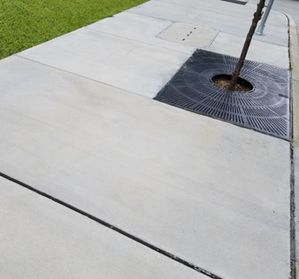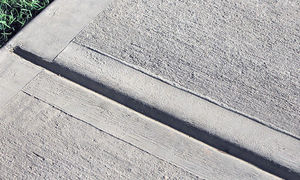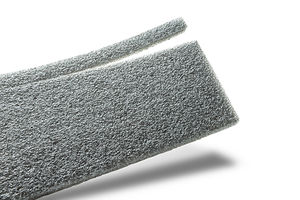 There’s some confusion about the correct treatment for expansion joints in concrete driveways, slabs, and larger construction such as roads or bridges. Expansion joints are full-depth gaps between individual poured-concrete slabs and are sometimes called isolation joints. The gaps allow the slabs to move with normal expansion, contraction or settling that occurs due to temperature changes or moisture conditions. If no expansion joints are planned in large runs of concrete, there is a tendency to form significant cracks where the movement causes severe stress points in the concrete. That kind of crack will weaken the structure and may mean early replacement of the whole slab. That’s an expensive correction to an unnecessary problem.
There’s some confusion about the correct treatment for expansion joints in concrete driveways, slabs, and larger construction such as roads or bridges. Expansion joints are full-depth gaps between individual poured-concrete slabs and are sometimes called isolation joints. The gaps allow the slabs to move with normal expansion, contraction or settling that occurs due to temperature changes or moisture conditions. If no expansion joints are planned in large runs of concrete, there is a tendency to form significant cracks where the movement causes severe stress points in the concrete. That kind of crack will weaken the structure and may mean early replacement of the whole slab. That’s an expensive correction to an unnecessary problem.
Traditionally those gaps have been filled with flexible, asphalt-impregnated fiberboard strips to support the edges and keep debris from filling the gaps and restricting that necessary movement. This is very common in large construction such as roads and bridges, but also larger driveways, pool decks and sometimes sidewalks. This filler needs to remain resilient and stand up to the pressure of the slab movement for the life of the slab itself. Fiberboard generally does a good job but may work its way out of the crack over time and need to be replaced. It also creates dark lines in the cracks that may be unsightly in residential applications such as driveways, patios and pool decks. Old installations of fiberboard can also hold moisture that could freeze/thaw in cold climates creating its own movement between the slabs.
 Expansion joints are often confused with control joints or contraction joints, which are the cuts made into a concrete pour that do not go all the way through the slab. They usually are less than ¼ of the depth of the slab and can be pressed
Expansion joints are often confused with control joints or contraction joints, which are the cuts made into a concrete pour that do not go all the way through the slab. They usually are less than ¼ of the depth of the slab and can be pressed
into the surface of the concrete while it is still wet or cut into the slab once cured. These joints are common in driveways and are meant to force any small, hairline fractures to follow the control joint when the concrete contracts during the cure period. It helps the cracks form in a predicable, desired path, keeps them from being noticeable, and they don’t affect the structure. The most shallow control cracks do not need gap filler or sealant of any kind.
Take a Crack at New Expansion Joint Solutions
 Armacell makes a new expansion joint solution that will allow the concrete movement, keep out debris and is moisture resistant. FillPro® Flat Backer Rod (FBR) is an expansion joint filler made of closed-cell, polyethylene which won’t swell or absorb water that might freeze in the winter. It’s semi-rigid, so it’s stiff enough slide into joints easily, but unlike bulky fiberboard, it will follow curves with ease. FillPro FBR is lightweight and sold in rolls that are 4” wide, ½” thick, and 50’ long lengths for easy transport and use. It can be used with cold-pour sealants or with none at all. When it’s used without a sealant, the light gray color blends with the color of the concrete, making the joint almost invisible. For even more convenience, the FBR filler strip is pre-slit with a ½” tear-off tab that can be left above the height of the concrete, then easily pulled away to make a flush installation (or placed slightly receded to leave room for sealant).
Armacell makes a new expansion joint solution that will allow the concrete movement, keep out debris and is moisture resistant. FillPro® Flat Backer Rod (FBR) is an expansion joint filler made of closed-cell, polyethylene which won’t swell or absorb water that might freeze in the winter. It’s semi-rigid, so it’s stiff enough slide into joints easily, but unlike bulky fiberboard, it will follow curves with ease. FillPro FBR is lightweight and sold in rolls that are 4” wide, ½” thick, and 50’ long lengths for easy transport and use. It can be used with cold-pour sealants or with none at all. When it’s used without a sealant, the light gray color blends with the color of the concrete, making the joint almost invisible. For even more convenience, the FBR filler strip is pre-slit with a ½” tear-off tab that can be left above the height of the concrete, then easily pulled away to make a flush installation (or placed slightly receded to leave room for sealant).

Armacell’s FillPro FBR Expansion Joint Filler Benefits:
- Moisture resistant, lightweight, long-lasting
- No special installation method needed, just insert with a blunt tool
- Won’t stain concrete
- Forms a bond-breaker to sealants
- Can be used with or without cold-pour sealants
- Suitable for residential, commercial, municipal and industrial applications
For more information on FillPro FBR, visit our sealant page here.
More information about concrete joints can be found here: https://www.concrete.org/tools/frequentlyaskedquestions.aspx?faqid=864
